Intel Details Manufacturing through 2023: 7nm, 7+, 7++, with Next Gen Packaging
by Ian Cutress & Anton Shilov on May 8, 2019 4:35 PM ESTAt Intel's Investor Day today, CEO Bob Swan and Murthy Renduchintala spoke to the ability of the company with respect to its manufacturing capabilities. Intel has historically been strong in its ability to execute on its process technology, however the delay of its 10nm process has obviously raised multiple question marks, and has done for several years. The two Intel executives went into a little detail about what Intel was doing in the interim, and how it has learned from the issues.
Back in 2013, Intel envisoned its 10nm to succeed the 14nm by providing 2.7x density, with new technologies such as Self-Aligned Quad Patterning (SAQP), Contact over Active Gate (COAG), Cobolt Interconnects, and new packaging technologies such as EMIB and Foveros. Intel admits that this was an ambitious plan, and the goals were not clearly defined with the teams and it was ultimately overly complex and not managed in an ideal way.
This ended up pushing 10nm out into a later time frame. In this case, Intel pushed 10nm out to 2019 (technically they shipped Cannon Lake in small quantities on 10nm in 2017, however that is nothing more than a curio in the timeline of semiconductors), and filled the gap with 14+ and 14++.
Intels 14+ and 14++ processes extracted more than 20% more performance (from Broadwell to Whiskey Lake) from the process since its inception. As a result, Intel is prepared to not only get ready for future intra-node optimizations, but actually adjust the roadmap to compensate for it. Murthy made it clear that Intel wants to introduce a Moore's Law-like gain at the beginning of a new process, and another similar gain by the end of the process.
Intel has stated that its 10nm product family (beyond Cannon Lake) will start to be available from the middle of this year (2019), with Ice Lake on client platforms (notebooks).
Intel will be launching multiple 10nm products through 2019 and 2020, including server based 10nm in the first half of 2020:
In the above slide, Intel states that it will have 7nm in production and launching a product in 2021. That sounds very aggressive for a company that has had issues with 10nm. It even shows in Intels radmap, with 10nm (and 10+ and 10++) having a much shorter life cycle than the 14nm family of processes.
With this in mind, Intel's 7nm is going to be the combination of what Intel has learned from the 14nm and 10nm family of products. Intel wants that 2x scaling (Moores Law), but with intra-node optimations planned as part of the roadmap. Intel is also reducing its number of design rules, which should help with execution. 7nm will also be where Intel intersects with EUV, and also introduce next-gen Foveros and EMIB packainging.
Intel provided this slide, which shows a monolithic PC-Centric die with a multi-die Data-Centric chip built on both Foveros and EMIB. This corroborates our discussion with Intel's chiplet and packaging team, who also stated that we would see Foveros and EMIB on a combined product - specifically the GPU.
Intel announced that its lead 7nm product (lead = top, or lead = first?) would be its new GPGPU, built on the Xe graphics architecture. Intel has stated that its Xe product stack will feature two different microarchitectures from mobile client up to GPGPU, with one of those architectures called Arctic Sound - technically Intel will launch its first discrete GPU in 2020 according to its press release, however the 7nm GPGPU will be launched in 2021.
More information is coming out of Intel's Event, more to follow.
Related Reading
- Intel: EUV-Enabled 7nm Process Tech is on Track
- Intel Starts Qualification of Ice Lake CPUs, Raises 10nm Volume Expectation for 2019
- Intel Agilex: 10nm FPGAs with PCIe 5.0, DDR5, and CXL
- Intel to Equip Fab 42 for 7 nm
- Intel Discloses Plans to Spend $5 Billion on Fab 28 Expansion in Israel
- Intel Submits Ireland Fab Expansion Plan: $8 Billion Price Tag, With a 4 Year Lead Time
- Intel Details Plans for Its Oregon Fab Expansion: D1X Phase 3
- Intel to Expand Production Capacities at Multiple Fabs
Source: Intel


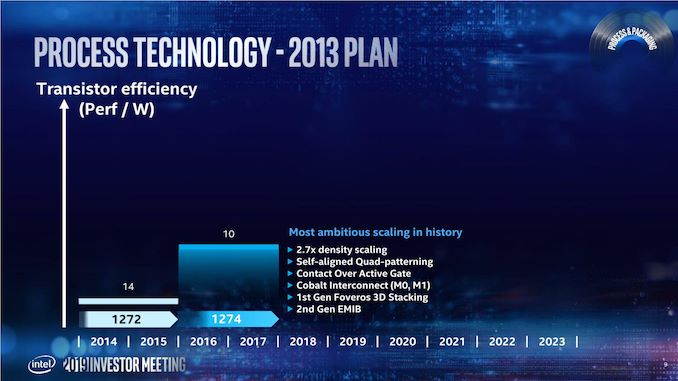

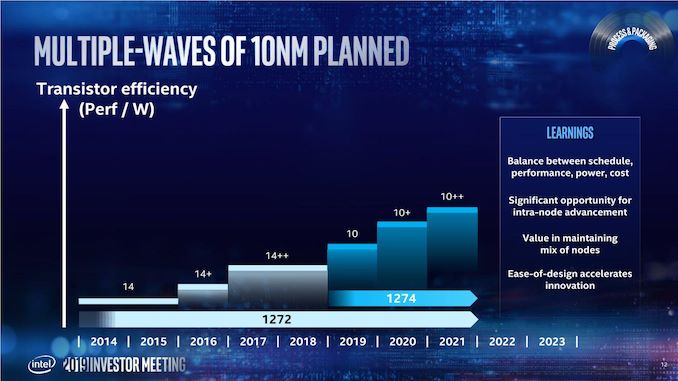
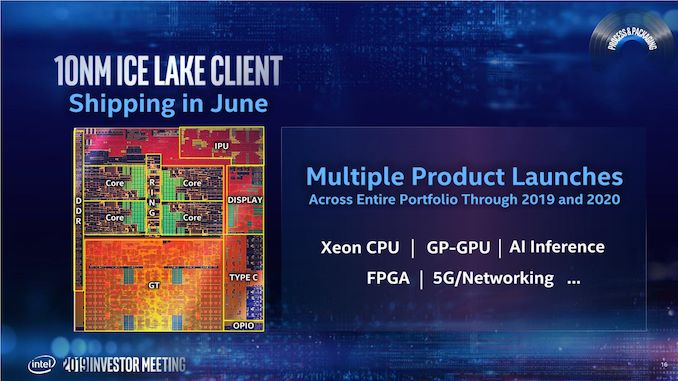
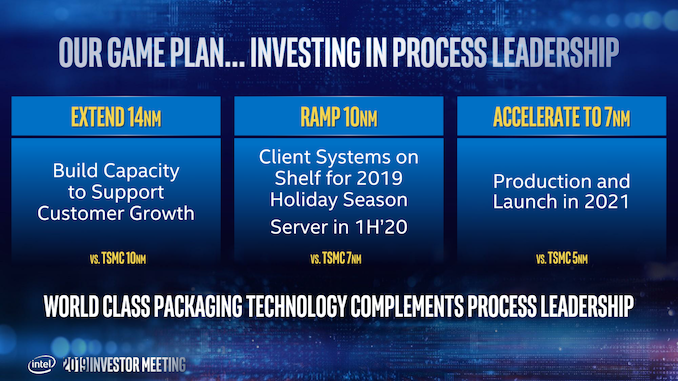
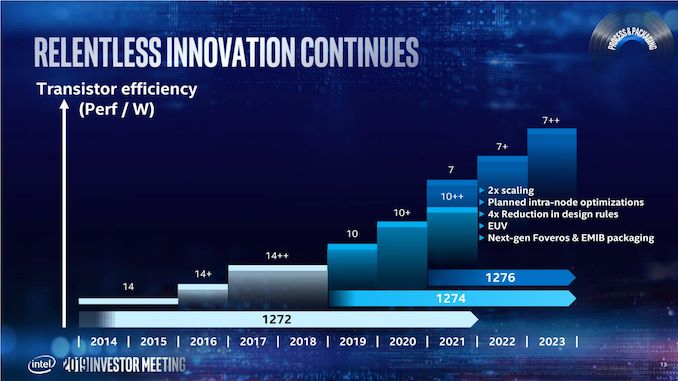










237 Comments
View All Comments
arashi - Saturday, May 11, 2019 - link
I see 30 years in Intel marketing means gaining the ability to have selective amnesia and terrible writing skills since the money did the actual talking.Xyler94 - Thursday, May 9, 2019 - link
I don't think you remember, but it took until the Core series to actually beat AMD in technical terms. Intel bribed manufactures to not use AMD parts, not because Intel was superior, but because it wasn't. Dell was famously paid off to not use Opteron CPUs for their datacenter servers, and it nearly caused them to lose all their customers because people wanted Opteron. And when Dell released Opteron CPUs, Intel cut their bribe money.Intel only held it's market lead due to shady tactics, not because of "domination". AMD was first with a compatible x86-64 instruction set, which was a 64 bit instruction able to do 32 bit also. And AMD was first to true multi-core CPUs with the Athlon x2. there's a reason why to this day the 64 bit extension is still reffered to as "AMD64".
You really are clueless to the actuality behind Intel. I love Intel Processors, but the thought of an affordable 12 or 16 core CPU is why I may go AMD next CPU.
Irata - Thursday, May 9, 2019 - link
They did for both P3 (frequency) and P4 ( performance). They still won the battle but that did not have much to do with technical merit.Still, a very shrewd business decision as the fines they had to pay were nothing compared to the financial gains they made by staying the dominant player.
Long term though, AMD having to sell their fabs turns out to have been a blessing for them.
Targon - Friday, May 10, 2019 - link
Yea, incompetence by government regulators allowed that to happen. Intel should have been FINED by the government to the tune of $20 billion, not counting what they paid to AMD in the settlement.Targon - Friday, May 10, 2019 - link
You mean the original Athlon vs. Pentium 3? Pentium 4 1.5GHz being roughly the same performance as a Pentium 3 running at 1.1GHz.Notmyusualid - Thursday, May 9, 2019 - link
@ Saturnus - meanwhile 9900K is the best CPU on the planet.Does that SOUND like 'catching up' to you? Honestly?
peevee - Thursday, May 9, 2019 - link
Is it though? For the price of 9900K you can buy 12-core Threadripper with SMT which adds +50% vs HT adding almost nothing on Intel, 50% more MT performance and twice memory throughput.Notmyusualid - Thursday, May 9, 2019 - link
Price doesn't concern me *that* much.9900K in my laptop is running 5.2GHz, and rocks my socks. Stable as Fort Perch Rock.
If I can buy TR in a laptop and run 5.2GHz, I'll buy it. No fanboism here.
Notmyusualid - Thursday, May 9, 2019 - link
...in addition, according to these guys:https://www.notebookcheck.net/Review-AMD-Ryzen-Thr...
I beat out that 12-core CPU on Cinebench R15 (assuming you mean 2nd gen too) by +16% Single Core, yet lose by 29% multicore (their scores).
Whilst I am a BIG fan of multicore CPUs (incidentially I just got rid of a Xeon 14c/28t 2960 v4), unless you have both the IPC *AND* the GHz, you just can't feed applications / GPUs as much as some require. My buddies 6700K SPANKED my 14 cores in gaming. Even with him on 1080 and me on 1080Ti.
And I haven't even begun to play with limits yet, just clicked the default 'Level 2 O/C', and I also beat out their 'Desktop' results too.
Irata - Thursday, May 9, 2019 - link
Considering the high amounts of power (and especially cooling) the i9-9900k needs at those frequencies, I very seriously doubt it is running @ 5.2 Ghz in a laptop.